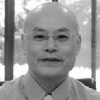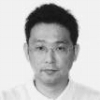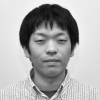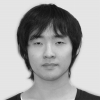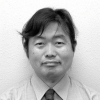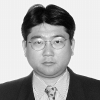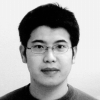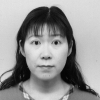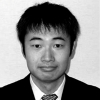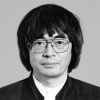DEPARTMENT OF INTEGRATIVE PHYSIOLOGY
Outline
Department of Integrative Physiology has two Laboratories, Laboratory of Sensori-Motor Integration (Chair: Ryusuke Kakigi) and Laboratory of System Neurophysiology (Chair: Atsushi Nambu). Although there are many departments named Integrative Physiology in Japan at present, Department of Integrative Physiology at NIPS was founded as the first one in Japan. Laboratory of Sensori-Motor Integration is investigating human brain functions using various methods of neuroimaging such as electroencephalography, magnetoencephalography, functional magnetic resonance imaging, near-infrared spectroscopy and transcranial magnetic stimulation. Laboratory of System Neurophysiology is investigating brain functions in animals, mainly monkey. In particular, they focus on the function of basal ganglia and cerebral cortex and their connection, and aim at clarifying pathophysiology and finding therapeutic methods of various diseases in humans by animal studies.
Division of Sensori-Motor Integration
We investigate human brain functions non-invasively mainly using magnetoencephalography(MEG) and electroencephalography (EEG), but recently we have also used functional magnetic resonance imaging (fMRI), transcranial magnetic stimulation (TMS) and near infrared spectroscopy (NIRS). Integrative studies using various methods are necessary to understand the advantages and disadvantages of each method. The following investigations are in progress at present.
(1) Sensory system: By recording brain responses to visual, auditory, somatosensory or pain stimuli, the organization of sensory processing in the human brain is being investigated. In particular, our interest is focused on the underlying mechanisms of pain and itch perception.
(2) Even-related brain responses: Using various psychophysical tasks or paradigms, we are investigating cognitive processing of the brain (higher brain functions). In particular, our interest is focused on the underlying mechanisms of face perception, inhibition processing using Go-NoGo paradigm, and masking phenomenon using repetitive stimuli,and brain response to mismatch stimulation.
(3) Application of brain research to society (Social brain): Recently we focused on the development of brain function in infants and children. EEG and NIRS are useful in this study, since these methods can be applied to infants and children who can not hold their heads still for a long time.
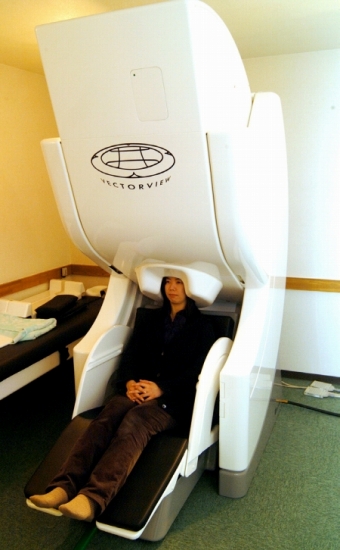
306-channel helmet-shaped MEG recording system (ELEKTA-Neuromag, Finland)
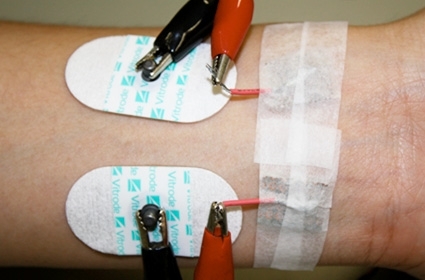
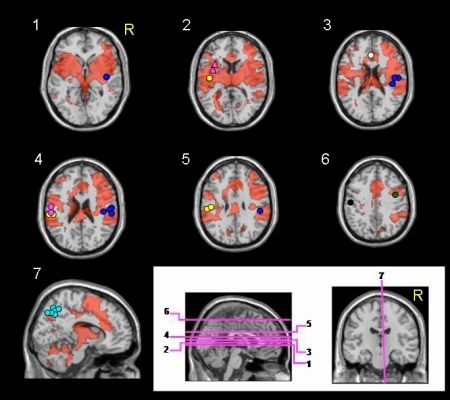
Newly developed stimulating electrodes inducing itch feeling (upper figure). MEG (yellow and blue circle) and fMRI (red regions) following itch stimulation indicate that secondary somatosensory cortex (SII), insula and precuneus in bilateral hemisphere are commonly activated by both methods (lower figure).
Staff
KAKIGI, Ryusuke, MD, PhD
1978 Graduated from Kyusyu University, Faculty of Medicine. 1981 Clinical Associate, Department of Internal Medicine, Saga Medical School. 1983-1985 Research Fellow, The National Hospital for Nervous Diseases, University of London. 1992 Assistant Professor, Department of Internal Medicine Saga Medical School. 1993 Professor, NIPS.
Speciality: Neurophysiology
INUI, Koji, MD, PhD
1989 Graduated from Saga Medical School, Faculty of Medicine. 1994 Completed the doctoral course in Psychiatry, Mie University. 1994 Assistant Professor, Department of Psychiatry, Mie Univertsity. 2000 Research fellow, 2001 Assistant Professor, NIPS.
Speciality: Neurophysiology, Psychiatry
MIKI, Kensaku, MD, PhD
2000 Graduated form Hamamatsu university school of medicine, 2004 Completed doctoral course in Life Science, the Graduate University of Advanced Studies. 2004 JSPS Research Fellow. 2008 Assistant Professor, NIPS.
Speciality: Neurophysiology
MORITA, Tomoyo, PhD
1994-1998 Faculty of Human Studies, Kyoto University, 2003 Completed the doctoral course in Graduate School of Human and Environmental Studies, Kyoto University. 2003. 2003 JSPS Research Fellow. 2006 JST Research Fellow. 2009 Assistant Professor, NIPS.
Speciality: Cognitive Neuroscience
WASAKA, Toshiaki, PhD
1997 Graduated from The University of Tokushima, Faculty of Integrated Arts and Sciences, 1999 Completed the master course in Human and Natural Environment Sciences, The University of Tokushima. 2004 Withdrawal of doctoral course in Health and Sports Sciences, University of Tsukuba. 2004-2008 Postdoctoral Fellow, NIPS. 2006-2010 Visiting Researcher, NIH, 2008-2010 JSPS Postdoctral Fellow for Research Abroad. 2010 Assistant Professor, NIPS.
Speciality: Neuroscience, Exercise Physiology
URAKAWA, Tomokazu, PhD
2005 Graduated from University of Miyazaki, Faculty of Engineering.
2010 Completed doctoral course in Life Science, the Graduate University for Advanced Studies. 2010 Postdoctoral Fellow, NIPS.
Speciality: Visual Neuroscience, Neurophysiology
NAKATO, Emi, PhD
1997 Graduated from Komazawa University, Department of Psychology. 2004 Completed the doctoral course in Psychology, Komazawa University. 2008 Research fellow, Research and Development Initiative, Chuo University. 2009 Postdoctoral Fellow, NIPS.
MATSUYOSHI, Daisuke, PhD
2003 Graduated from Faculty of Sociology, Kansai University. 2006, Completed Master's Course in Psychology, Graduate School of Letters, Kyoto University. 2009 Completed the Doctoral Course in Psychology, Graduate School of Letters, Kyoto University, 2009 Postdoctoral Fellow NIPS.
Speciality: Psychophysics, Cognitive Neuroscience
MATSUMOTO, Atsushi, MA
2002 Graduated from Department of Psychology, Nagoya University. 2004 Completed the master course in Graduate School of Environmental Studies, Nagoya University. 2007 Completed the doctoral course in Graduate School of Environmental Studies, Nagoya University. 2007-JSPS Research Fellow.
Specialty: Neuroscience, Psychophysiology
OTSURU, Naofumi, PhD
2005 Graduated from Kobe University School of Medicine, Faculty of Health Science. 2007 Completed the Master's Course in Health Science, Kobe University. 2010 Completed the Doctoral Course in Life Sceince, the Graduate University of Advanced Studies. 2010 Postdoctoral Fellow NIPS.
Speciality: Neurophysiology, Rehabilitation
MIYAZAKI, Takahiro, MD, PhD
1994 Graduated from Kyoto University, Faculty of Science, 2000 Graduated from Tokyo Medical and Dental University, Faculty of Medicine, 2000 Resident, Keio University Hospital, 2010 Graduated from The Graduated University for Advanced Studies, School of Life Science, 2010 Postdoctoral Fellow, National Institute for Physiological Sciences.
Living animals, including human beings, obtain many pieces of information from the external and internal environments, integrate them to make a decision for appropriate behavioral activity, and finally take action based on self-intension. The brainareas, such as the cerebral cortex, basal ganglia and cerebellum, play a major role in the voluntary movements. On the other hand, malfunctions of these structures result in movement disorders, such as Parkinson's disease. The major goal of our research programs is to elucidate the mechanisms underlying higher motor functions and the pathophysiology of movement disorders. To explore such intricate brain functions, we employ a wide range of neurophysiological and neuroanatomical techniques.
The current topics under study are as follows: 1) Elucidation of information flows through the neuronal networks by electrophysiological and anatomical methods; 2) Understanding the mechanism how the brain controls voluntary movements by electrophysiological recordings of neuronal activity from animals performing motor tasks, combined with local injection of neuronal blockers or optogenetics; 3) Elucidation of the pathophysiology of movement disorders by recording neuronal activity from animal models; 4) Understanding the pathophysiology of movement disorders by analyzing neuronal activity recorded in human patients during stereotaxic surgery.
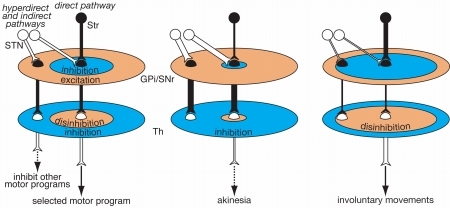
Schematic model explaining functions of the basal ganglia and pathophysiology of movement disorders. The hyperdirect, direct and indirect pathways control the activity of the thalamus (Th), and relaease only the selected motor program at the appropriate timing (left). In hypokinetic disorders such as Parkinson's disease (center), reduced disinhibition in the thalamus through the direct pathway results in akinesia. On the other hand, reduced activity in the GPi/SNr induces excessive disinhibition on the thalamus and results in involuntary movements in hyperkinetic disorders such as dystonia (right).
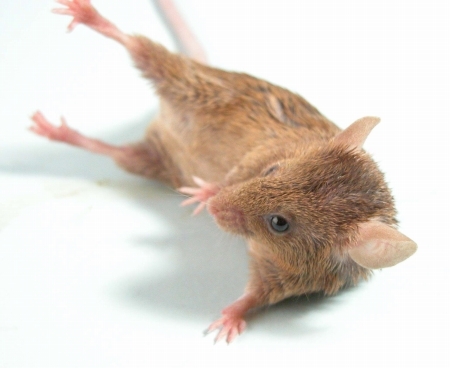
Wriggle Mouse Sagami, one of the models of movement disorders.
Staff
NAMBU, Atsushi, MD, PhD
1982 Graduated from Kyoto University, Faculty of Medicine. 1985 Research Associate, Kyoto University, School of Medicine. 1989 Postdoctoral Fellow, New York University, Faculty of Medicine. 1991 Associate Professor, NIPS. 1995 Director, Tokyo Metropolitan Institute for Neuroscience. 2002 Professor, NIPS.
Speciality: Neurophysiology
HATANAKA, Nobuhiko, DDS, PhD
1996 Graduated from Ohu University, Faculty of Dentistry. 1996 Resident at Ohu University Hospital. 1997 Research Associate, Ohu University, Faculty of Dentistry. 1998 Research Fellow, Tokyo Metropolitan Institute for Neuroscience. 2003 Assistant Professor, NIPS.
Speciality: Neurophysiology, Neuroanatomy
TACHIBANA, Yoshihisa, DDS, PhD
1999 Graduated from Osaka University, Faculty of Dentistry. 2003 Completed the doctoral course in Dental Sciences, Graduate School of Osaka University. 2003 Research Fellow, NIPS. 2003 Assistant Professor, NIPS.
Speciality: Neurophysiology
CHIKEN, Satomi, PhD
1994 Graduated from Tokyo Metropolitan University, Department of Biological Sciences. 1999 Completed the doctoral course in Biological Sciences, Graduate School of Tokyo Metropolitan University. 2000 Research Fellow, Tokyo Metropolitan Institute for Neuroscience. 2002 Research Fellow, Japan Society for the Promotion of Science. 2006 Assistant Professor, NIPS.
Speciality: Neurophysiology, Neurobiology
SANO, Hiromi, PhD
1997 Graduated from Kyoto Pharmaceutical University. 1999 Completed the master course in Graduate School of Biological Science, Nara Institute of Science and Technology. 2003 Completed the doctoral course in Graduate School of Biological Science, Nara Institute of Science and Technology. 2003 Research Associate, Fukushima Medical University. 2004 Research Associate, Kyoto University, Graduate School of Medicine. 2007 Postdoctoral Fellow, NIPS. 2008 Project Assistant Professor, NIPS.
Speciality: Molecular neurobiology
KOKETSU, Daisuke, PhD
2000 Graduated from Faculty of Liberal Arts, ICU. 2005 Completed the doctoral course in Graduate School of Frontier Sciences, The University of Tokyo. 2005 Research Fellow of Japan Society for the Promotion of Science, Primate Research Institute, Kyoto University. 2010 Project Assistant Professor, NIPS.
Speciality: Neurophysiology
TAKARA, Sayuki, PhD
2003 Graduated from Kyushu Institute of Technology. 2005 Graduated from the master course in Department of Brain Science and Engineering, Kyushu Institute of Technology. 2008 Completed the doctoral course in Life Science, the Graduate University for Advanced Studies. 2008 Postdoctral Fellow, NIPS.
Speciality: Neurophysiology
The goal of the Division of Computational Neuroscience is to clarify roles of nonlinear dynamics in neural systems for realization of brain functions. In particular, we are elucidating how a diversity of phenomena in nonlinear dynamical systems, e.g., bistability, entrainment, chaos, and transitive dynamics, are involved in various cognitive functions such as memory and attention. We are also combining mathematics and physiology, e.g., by trying conductance injection (dynamic clamp) and developing a new method to analyze in vivo data, and exploring the way to make biologically sound models and testable predictions.
(A)
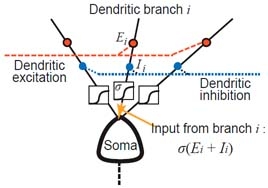
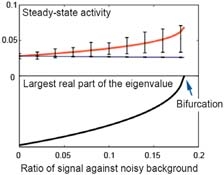
(B)
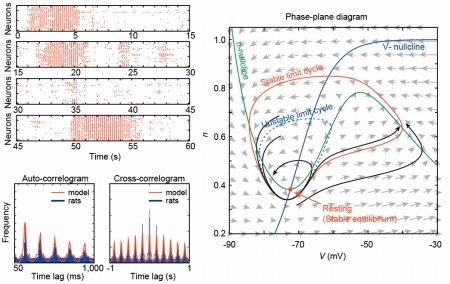
(A) Neocortical pyramidal cells have extensively branched dendrites, and recent physiological studies have shown that integration of synaptic inputs in each dendritic branch may entail nonlinearity (Left, schematic diagram). Analyzing a mathematical model of microcircuit incorporating a reduced form of such branch-specific nonlinear integration, it was suggested that the dendritic nonlinearity may contribute to the stability of the circuit against noisy background inputs (Right, there exists a low-activity stable state when the S/N ratio is small: Morita et al., Neural Comput, 2007). (B) Inferior olive (IO) neurons show intriguing spatio-temporal dynamics with rhythmic and synchronized spiking. We proposed a gap junction-coupled network composed of simple conductance-based model neurons and optimized its parameter values so that the network reproduce the patterns of spike activity recorded from IO neurons in rats (Left ). Analyses of the model imply that both intrinsic bistability of each neuron (Right ) and the gap junction coupling play key roles in the generation of the spatio-temporal dynamics (Katori et al., IJBC, 2009).
Staff
AIHARA, Kazuyuki
1982 Completed the doctoral course at the University of Tokyo. Currently, he is Professor of Institute of Industrial Science, Graduate School of Information Science and Technology, Graduate School of Engineering, and Director of Collaborative Research Center for Innovative Mathematical Modelling, the University of Tokyo.
Speciality: mathematical neuroscience
